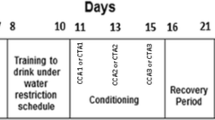Abstract
Mice from four inbred strains and a heterogeneous line were first reduced to 90% of theirad libitum body weight and were then trained to press a bar to obtain food pellets. After 9 days of training with a continuous schedule of reinforcement (CRF), mice were required to discriminate between conditions of reward and nonreward as indicated by a tone and a light; discrimination training continued for 21 days. Considerable genetic variation was apparent for asymptotic pressing rates under CRF as well as discrimination performance. However, the highest discrimination ratios were achieved by mice with the lowest pressing rates. Results are discussed in terms of associative and nonassociative processes which may contribute to genetic variation in performance on learning tasks.
Similar content being viewed by others
References
Alpern, H., and Marriott, J. (1972). An analysis of short term memory and conceptual behavior in three inbred strains of mice.Behav. Biol. 7:543–552.
Anisman, H. (1974). Differential effects of scopolamine andd-amphetamine on avoidance behaviors in three strains of mice. Unpublished manuscript.
Barrett, R. J., Leith, N. J., and Ray, O. S. (1973). A behavioral and pharmacological analysis of variables mediating active-avoidance behavior in rats.J. Comp. Physiol. Psychol. 82:489–500.
Bitterman, M. E., and Schoel, W. M. (1970). Instrumental, learning in animals: Parameters of reinforcement.Ann. Rev. Psychol. 21:367–436.
Bolles, R. C. (1967).Theory of Motivation, Harper & Row, New York.
Carlton, P. L. (1969). Brain-acetylcholine and inhibition. In Tapp, J. T. (ed.).Reinforcement and Behavior, Academic Press, New York.
Fuller, J. L. (1970). Strain differences in effects of chlorpromazine and chlordiazepoxide upon active and passive avoidance in mice.Psychopharmacologia 16:261–271.
Goodrick, C. L. (1967). Learning and retention of a light contingent bar press response for three inbred strains of mice.J. Psychol. 67:191–199.
Kimble, G. A. (1961).Hilgard and Marquis Conditioning and Learning. Appleton-Century-Crofts, New York.
McClearn, G. E., Wilson, J. R., and Meredith, W. (1970). The use of isogenic and heterogenic mouse stocks in behavioral research. In Lindzey, G., and Thiessen, D. D. (eds.),Contributions to Behavior-Genetic Analysis, Appleton-Century-Crofts, New York.
Oliverio, A., Castellano, C., and Messeri, P., (1972). A genetic analysis of avoidance, maze and wheel running behaviors in the mouse.J. Comp. Physiol. Psychol. 79:459–473.
Oliverio, A., Castellano, C., and Messeri, P. (1973). Genotype-dependent effects of septal lesions on different types of learning in the mouse.J. Comp. Physiol. Psychol. 82:240–246.
Padeh, B. (1972). A genetic analysis of operant discrimination learning and brain size in inbred and heterogeneous strains of laboratory mice. unpublished Ph.D. dissertation, University of Colorado.
Schlesinger, K., and Wimer, R. (1967). Genotype and conditioned avoidance learning in the mouse.J. Comp. Physiol. Psychol. 63:139–141.
Smart, J. L. (1970). Trial-and-error behaviour inbred and F1 hybrid mice.Anim. Behav. 18:445–453.
Southwick, C. H., and Clark, L. H. (1968). Interstrain differences in aggressive behavior and exploratory activity of inbred mice.Commun. Behav. Biol. 1:49–59.
Teitelbaum, P. (1966). The use of operant methods in the assessment and control of motivational states. In Honig, W. K. (ed.),Operant Behavior: Areas of Research and Application, Appleton-Century-Crofts, New York.
Wahlsten, D. (1972a). Phenotypic and genetic relations between initial response to electric shock and rate of avoidance learning in mice.Behav. Genet. 2:211–240.
Wahlsten, D. (1972b). Genetic experiments with animal learning: A critical review.Behav. Biol. 7:143–182.
Wahlsten, D. (1973). Contributions of the genes albinism (c) and retinal degeneration (rd) to a strain-by-training procedures interaction in avoidance learning.Behav. Genet. 3:303–316.
Author information
Authors and Affiliations
Additional information
This research was supported in part by NIGMS grant GM-14547 to the Institute for Behavioral Genetics University of Colorado.
Rights and permissions
About this article
Cite this article
Paden, B., Wahlsten, D. & DeFries, J.C. Operant discrimination learning and operant bar-pressing rates in inbred and heterogeneous laboratory mice. Behav Genet 4, 383–393 (1974). https://doi.org/10.1007/BF01066158
Received:
Accepted:
Issue Date:
DOI: https://doi.org/10.1007/BF01066158




